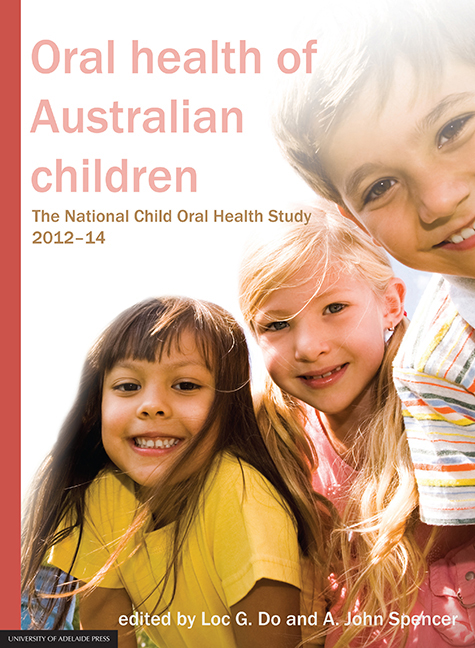Book contents
- Frontmatter
- List of Contributors
- Contents
- Preface
- Executive Summary
- 1 Children's oral health – assessing and improving oral health
- 2 Measuring child oral health and its influences
- 3 Data weighting, consideration and estimation procedures
- 4 Measuring representativeness of the study participants
- 5 Children's oral health status in Australia, 2012–14
- 6 Patterns of dental services use by Australian children
- 7 Australian children's oral health behaviours
- 8 Australian children's general health behaviours
- 9 Social gradients in child oral health
- 10 Oral health status and behaviours of Indigenous Australian children
- 11 Trends in child oral health in Australia
- 12 Interpretation of findings and a way forward to improving oral health and dental care
- 13 Appendix
- State and territory survey personnel
- Symbols
- Abbreviations
- Place names
- Glossary
- List of tables
- List of figures
1 - Children's oral health – assessing and improving oral health
Published online by Cambridge University Press: 05 September 2017
- Frontmatter
- List of Contributors
- Contents
- Preface
- Executive Summary
- 1 Children's oral health – assessing and improving oral health
- 2 Measuring child oral health and its influences
- 3 Data weighting, consideration and estimation procedures
- 4 Measuring representativeness of the study participants
- 5 Children's oral health status in Australia, 2012–14
- 6 Patterns of dental services use by Australian children
- 7 Australian children's oral health behaviours
- 8 Australian children's general health behaviours
- 9 Social gradients in child oral health
- 10 Oral health status and behaviours of Indigenous Australian children
- 11 Trends in child oral health in Australia
- 12 Interpretation of findings and a way forward to improving oral health and dental care
- 13 Appendix
- State and territory survey personnel
- Symbols
- Abbreviations
- Place names
- Glossary
- List of tables
- List of figures
Summary
Being orally healthy means that people can eat, speak and socialise without discomfort or embarrassment and without active disease in their mouth which affects their overall wellbeing (UK Department of Health 1994). Australians of all ages have an expectation of being orally healthy, but this is particularly relevant to children. Children constitute a special population group requiring attention and consideration because of the importance of maximising the opportunities of childhood as a key developmental stage and the foreshadowing of later adult oral health and wellbeing.
There are two highly prevalent oral diseases and disorders affecting the teeth and their supporting tissues: dental caries (decay) and periodontal diseases (gum disease). There are a number of less frequently occurring but nonetheless important oral diseases of the oral mucosa as well as disorders such as developmental defects, dental impactions, malocclusions, tooth wear, jaw joint dysfunction and dental and oral trauma (AHMAC, Steering Committee for National Planning for Oral Health 2001). Among children, dental caries, early stage periodontal disease (gingivitis), and developmental defects like dental fluorosis, oral mucosal lesions and trauma, are the most frequent and impacting oral diseases and disorders. These conditions severally and collectively cause pain and discomfort, eating difficulties, speech and cognition dysfunction, embarrassment and social marginalisation. These impacts are no different to the impacts of many other diseases and ill-health. Just as the mouth is an integral part of the body, oral health is an essential component of overall child health and quality of life.
Risks and prevention of dental caries
Among children, dental caries is the leading oral disease. It has high prevalence and associated high impact on children and their families. Its presence dominates the need for dental services and the cost of them both to families and society.
Historically, Australian children have experienced a high level of oral disease. In the immediate post-WW2 period, Australian children had one of the highest levels of dental caries among comparable developed countries (Barnard 1956). By the 1990 decade Australia's child oral health surveillance had reported a marked improvement in experience of dental caries. However, in the last two decades, the improvement in oral health of Australian children has ceased or even reversed (Armfield et al. 2010).
- Type
- Chapter
- Information
- Oral Health of Australian ChildrenThe National Child Oral Health Study 2012-14, pp. 1 - 14Publisher: The University of Adelaide PressPrint publication year: 2016



